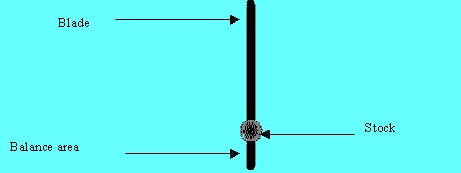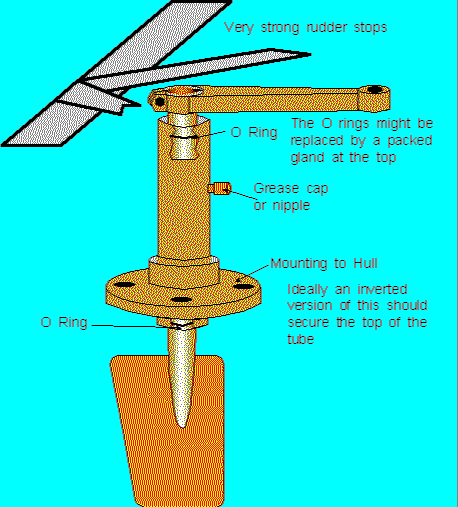Home Index
On
| Back | Home Index |
On |
We have already seen that a boat incorrectly trimmed is likely to be difficult to steer. Experience shows that some boats steer well whilst others are difficult.
By recognising hull and rudder characteristics you can get some idea if a particular hull will respond in the way you wish. This understanding also allows you to consider modifications to improve handling.
Because steering and directional stability rely upon dynamic water flows which vary according to subtle differences in hull shape, waterway, trim etc, this is another "black art" area.
To get a grip on understanding this topic we will look at hull types at the "extreme" ends of the range. Any names given are to assist recognition, they are not widely accepted.
TRADITIONAL HIRE CRUISER TYPE – tends to have a long keel, increasing in depth as it nears the stern. The rudders tend to be large.
These hulls tend to run straight or have only minor tendency to veer one way or the other.
The rudder is used to "force" the boat into a change of direction.
This type will be controllable with the power off.
HANDY TYPE – Little or no keel and a small rudder. May be trimmed flat.
This type tends to only run straight when the rudder has influence. The hull with no rudder tends to veer all over the place.
The rudder is used to keep the hull running straight and produce a "nudge" in the direction required when turning. The hulls instability then tends to turn the boat.
Is unlikely to be controllable with the power off because propeller wash is used to enhance the action of the small rudder.
NON-POWERED TYPE – As used on towed barges and Butty boats. The rudder is very large and gives the hull both directional stability and forces it to turn.
Conclusions
Putting an outdrive or outboard on a "Handy" type hull is unlikely to give an easy to steer boat (unless a rudder attachment is also fitted).
A lot of low speed manoeuvring is likely to favour the "Hire boat" type.
High speed manoeuvring in confined spaces is likely to require the "handy" type.
A powered boat which needs to do a lot of "power off" manoeuvring should tend towards a large rudder.
If we leave the "patent" steering systems alone, rudders fall into two main types:-
UNBALANCED RUDDER – This type is typically hung on the sternpost or transom. The whole of the rudder is behind the stock (the "pole" the rudder blade is fitted to). The steering gear (and helmsperson) has to withstand the full steering forces.
BALANCED TYPE – A portion of the blade is extended in FRONT of the stock. This allows water pressure on the extended part provide assistance, so the steering gear does not have to withstand the full steering force. This is shown below.

There are two main theories as to how rudders steer boats.
HYDRO-DYNAMICALLY – The water flowing over the rudder causes it to act like an aeroplane wing.
The water flowing in front of the rudder takes a shorter path than that flowing around the back. This causes a lower pressure on the back so the rudder "flies" sideways and to an extent backwards through the water, pushing the stern of the boat away from the direction of turn.
If this rudder is turned through much more than about 45 degrees the smooth water flow will start to eddy and the rudder will stall – just like an aircraft. Aircraft fall out of the sky, the boat just stops turning.
OFFSET DRAG – A turned rudder puts more drag on one side of the boat's centre line. This causes the side of the boat without the drag to
try and "run round" the side with drag, thus the boat turns as shown.
You lecturer suspects this is more applicable to large rudders at low speed.
TRACK THROUGH WATER
In either method above, it can be seen that the forces acting to turn the boat are not directly produced by rudder angle. The actual track through the water is not directly related to rudder angle.
The speed of the prop wash past the rudder has a great influence.
Never turn the rudder to an angle of much more than 45 degrees, especially if the water moving over the rudder is travelling at any speed.
Because the marine industry is fragmented with many vastly different areas of operation, the design of steering gear still varies from boat to boat and type to type. It runs from simple timber designs on wooden working boats, through "agricultural" metal ware on narrow boats to sophisticated powered helms on fast cruisers. Wooden and metal tiller designs are usually simple and basic and give little trouble, most problems occur on steering gear totally fitted within the hull. A typical rudder assembly is shown below.

Note that this assembly is fitted to the hull AT THE BOTTOM ONLY. Also, note that the rudder blade hangs down below the hull to form a very effective lever.
How heavy is your boat? My boat weighs about 15 tons, a reasonable sized river cruiser will weigh perhaps 3 to 5 tons.
Now consider – I am making a turn with the stern swinging round very well, probably faster than the forward speed of the boat. The rudder contacts a lump of submerged rock, concrete, or even a mud bank. The rudder tries to stop dead, whilst the hull continues to swing.
I would get myself thrown overboard by the tiller, but a cruiser with the rudder gear shown faces the following:-
Without a upper support the rudder tube gets wrenched out of the hull – the boat sinks.
Without very strong rudder stops the steering cable or rods get badly bent or are forced over centre – the boat then emulates the oozalam bird, going in ever decreasing circles.
The blade gets bent or snaps off
The stock bends
The rudder arm slips on the stock, possibly sheering the key in the process.
If the blade is bolted to the stock, the bolts break and the blade falls out.
These problems also occur when the rudder is reversed against something – even quiet soft mud!
If the boat has a skeg (a strong metal one (I hope – wooden ones wear by prop wash and snap off)) and a rudder bearing below the blade the stock is protected from being bent and the tube assembly is protected from being ripped out of the hull.
Most small GRP cruisers do not have a skeg so the steering gear is very vulnerable.
PROTECTION FROM DAMAGE
Inspect your steering gear, if it has similarities to the one shown seriously consider the following modifications:
Fit a very strong support to the top of the rudder tube that spreads load over large hull areas.
Fit very strong rudder stops that lets the rudder turn to about 45 degrees either side of centre. Again make sure any load transferred to the hull is spread over a large area.
WEAR
The design illustrated is lubricated by a grease cap, some use a grease nipple. A nipple is not such a good idea because, even if it has a brass body, its ball and spring are likely of be of steel that rusts and leaks.
Often access to the steering gear is difficult so the lubrication only takes place once a year if you are lucky.
Wear in the tube is very common. This allows even new O rings to leak that can only be cured by a new assembly or modification to use lip type seals (perhaps).
If the tube is sealed by a gland, leakage is a distinct possibility because the packing is worn. Again, difficult access means it is rarely re-packed.
All the above leaks normally only show, in the first instance, when in full ahead with some helm on.
Especially on wooden boats, but also on GRP ones with inadequate build methods, the constant "buffeting" of the rudder by the prop wash causes the assembly to work loose. This causes leaks at the base.
Solving the problems
Fit a remote greaser, and use it, to minimise wear.
Institute regular inspections
Repack/adjust any gland at least twice a year.
Unexplained water in the bilge must be checked – many people forget the rudder gear.
OTHER MAINTENANCE
Inspect your boat's steering gear. Find all the grease nipples, even if you have to remove panels.
Institute regular procedures to:-
Check all steering joints for wear.
Check all fixings for security
Lubricate all moving points and nipples.
Now you are feeling smug, the "ditch crawlers" amongst you can go and dry your trouser leg and shoe where the prop wash shot out of the top rudder bearing when you were not paying attention.
| Back | Home Index |
On |